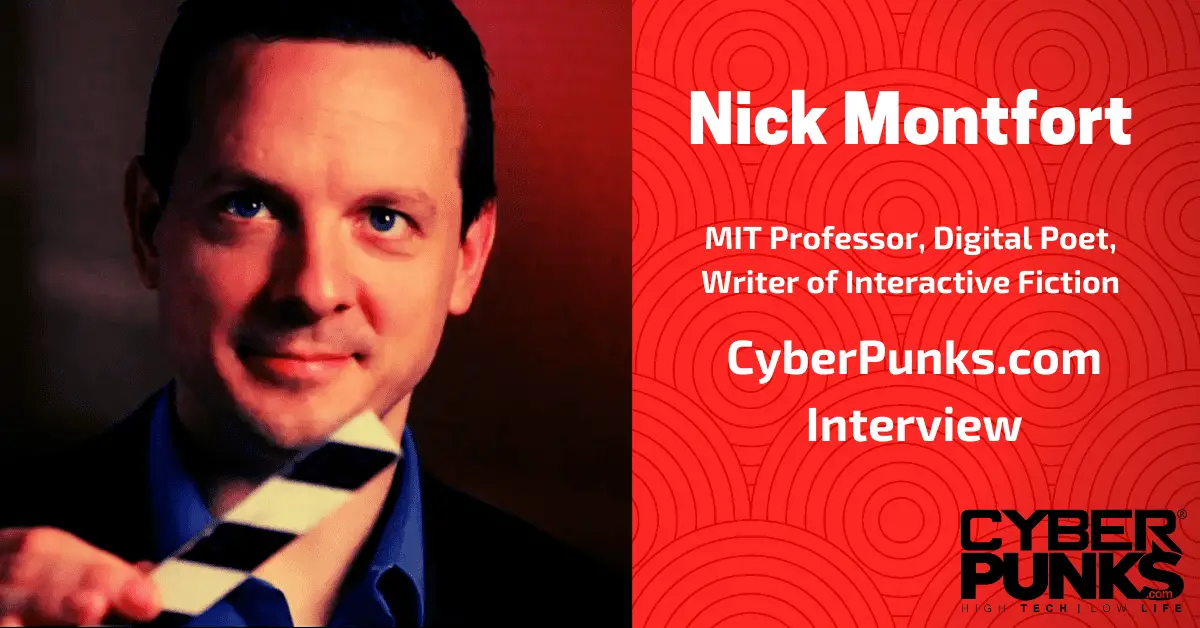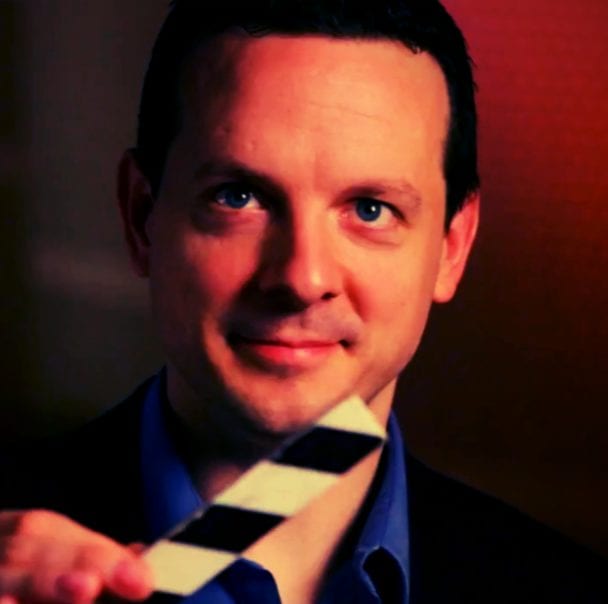
Nick Montfort is a digital poet and professor of Digital Media at MIT. He is the author of several algorithm-generated poetic works, as well as interactive fiction, and conventional books. His most recent works include The Future (2017), a discussion on the development of technologies and essential knowledge about the future, and The Truelist (2017), a book- length poem generated by a one-page, stand-alone computer program.
BEING A POET IN THE DIGITAL AGE
You live at really interesting intersection of media real estate – being known as both a poet and a professor of digital media. How much do those two things overlap and intersect? Do ideas come from being around the younger generation and seeing their embrace of digital media?
People don’t have to be students at MIT — or faculty there for that matter — to have good ideas. I have friends and collaborators who engage with digital media thoughtfully and range in age widely, some decades older and some decades younger than me.
Grand Text Auto is a rather old blog in terms of the internet era; when did you initially come on board with it, and what do you think is most appealing about it?
I was one of the four founders in May 2003, before the first version of WordPress was released. The blog, which ran on a different system initially, is pretty old, yes. Grand Text Auto really ran until May 2009; there is a current version of the site, but it aggregates posts from our individual blogs rather than being the original group blog. The blog was a great conversation that had the constant attention of the six of us who were the “drivers” and posted on it, but also had participation from a wide community, mostly academics, who commented, often carrying on for dozens of comments. The conversation and community were what made these six years interesting. We drivers also all had some dimension as digital art or media practitioners, making the stuff in various ways, while we each additionally did scholarship, research, criticism, or theoretical writing on the topic. It was a very different time in terms of online discussion and community, and there’s no paragraph that could convey the contrast between that time and today’s corporate social media environment.
POETRY REMIXES AND INTERACTIVE FICTION
The idea of remixing poems like they are music tracks is interesting and one I’m not totally familiar with. How involved with that are you? What are your feelings on it overall? Do you know how it came about? Was that something you were also involved with?
You probably want to look at my digital poem “Taroko Gorge,” which has been what people call “remixed” many times. There are dozens of published versions, and including when it is used in classroom assignments I’m sure that hundreds of remixes have been made. These involve modifying computer programs, editing code. Remixing sounds cooler than modifying code, so people use that term. This modification of programs is a great way for all sorts of programmers, whether beginners or experts, to engage with existing digital work and make something that is exciting out of it, tweaking things about the original work but also opening up new concepts, perspectives, and possibilities. I have remixed classic text generators myself, for instance doing a modified version of the 1967 computer-generated poem “A House of Dust” by Alison Knowles and James Tenney. My poem is called”Use of Dust” and was developed by erasure — simply removing parts of the original text.
You write “Twisty Little Passages: An Approach to Interactive Fiction.” For those who haven’t read it (but obviously should) what’s the thrust of the concepts? Do you consider the concept of Interactive Fiction to be its own true media, or as an offshoot of video games?
The best way to see what interactive fiction is is to play some, whether or not one wants to read my book. You can choose from literally thousands of free options, available online.
Do you see consumer technologies advancing the arts of code-based poetry and interactive fiction? Where do you see these things going next?
I don’t think companies are putting out products that somehow are, by themselves, going to give a boost to digital literary art. Advances are happening because of the efforts of poets and writers, for the most part those who also program and deeply engage with computation.
As a creative I find myself drawn to fiction literature, comic books and things of that nature. Where do you see technology pushing these and other forms of pop culture? I often talk about a “streaming wars” between the various services and companies all dividing up and trying to control more forms of media and content; where do you see technology and business taking those ideas?
You seem to expect technology to push culture along, but why does that have to be the only direction of influence? Cyberpunk fiction was not somehow determined by the advance of technology. William Gibson wrote Neuromancer on a manual typewriter. It seems more plausible that cyberpunk fiction helped to define or at least inspire what VR would become, for instance, and helped to shape attitudes toward the corporate control of computing technologies.
What are your thoughts for the future of the intersection of technology and humanity? Those are the two main ingredients of Cyberpunk as a genre.
They are laid out in my recent book The Future, part of the Essential Knowledge series by MIT Press. People can use innovation in digital media as one of many ways to write, build, and collaborate on a positive future for humanity. Another way to help make the future is by developing utopian and dystopian writing, grappling with the future though science fiction, for instance. Developing a better future together isn’t, of course, something that will happen automatically, whether we develop technology further or just write a lot. We need to be thoughtful and attend to the perspective from which our ideas are being seen.
How do you see emerging interactive paradigms like AR/VR allowing for growth in the creative computing space? Will these would allow for robust new forms of expression?
People would love for it to happen. It won’t happen because of the technology itself.
FURTHER READING
The Future by Nick Montfort
The future is like an unwritten book. It is not something we see in a crystal ball, or can only hope to predict, like the weather. In this volume of the MIT Press’s Essential Knowledge series, Nick Montfort argues that the future is something to be made, not predicted. Montfort offers what he considers essential knowledge about the future, as seen in the work of writers, artists, inventors, and designers (mainly in Western culture) who developed and described the core components of the futures they envisioned.
The Truelist by Nick Montfort
Poetry. Art. THE TRUELIST is a book- length poem generated by a one-page, stand-alone computer program. Based around compound words, some more conventional, some quite unusual, the poem invites the reader to imagine moving through a strange landscape that seems to arise from the English language itself. The unusual compounds are open to being understood differently by each reader, given that person’s cultural and individual background. The core text that Nick Montfort wrote is the generating computer program. It defines the sets of words that combine, the way some lines are extended with additional language, the stanza form, and the order of these words and the lines in which they appear. The program is included on the last page. Anyone who wishes is free to study it, modify it to see what happens, and make use of it in their own work.
Twisty Little Passages: An Approach to Interactive Fiction by Nick Montfort
Twisty Little Passages looks at interactive fiction beginning with its most important literary ancestor, the riddle. Montfort then discusses Adventure and its precursors (including the I Ching and Dungeons and Dragons), and follows this with an examination of mainframe text games developed in response, focusing on the most influential work of that era, Zork. He then considers the introduction of commercial interactive fiction for home computers, particularly that produced by Infocom. Commercial works inspired an independent reaction, and Montfort describes the emergence of independent creators and the development of an online interactive fiction community in the 1990s. Finally, he considers the influence of interactive fiction on other literary and gaming forms. With Twisty Little Passages, Nick Montfort places interactive fiction in its computational and literary contexts, opening up this still-developing form to new consideration.
Neuromancer by William Gibson
“Case was the best interface cowboy who ever ran the earth’s computer matrix. Then he crossed the wrong people. . . .” This is one of the books that started the cyberpunk movement. Written in 1984, this work by Gibson conceived of such things as cyberspace, jacking in, and computer punk.





